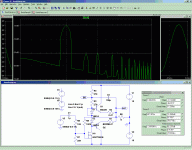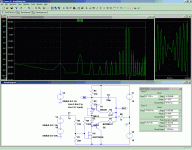In most cases the mentioned IM values are above the THD values. But there are amps, where this is reversed, e. g. by the Altec 9444B, go to
Altec Lansing Professional Amplifier 9444B Specification List page 6
Is this possible in general, and if yes, what means this for the audible perception by listening tests?
So far I have never noticed this detail.
Altec Lansing Professional Amplifier 9444B Specification List page 6
Is this possible in general, and if yes, what means this for the audible perception by listening tests?
So far I have never noticed this detail.
It is not only possible, but even very likely.
Some examples are discussed here:
http://www.diyaudio.com/forums/equipment-tools/188169-low-distortion-oscillator-3.html#post2559836
And you can see that for a severe case of crossover distortion, the IMD is practically non-existent.
At least the first order IMD, which is nearly always what is specified.
Some examples are discussed here:
http://www.diyaudio.com/forums/equipment-tools/188169-low-distortion-oscillator-3.html#post2559836
And you can see that for a severe case of crossover distortion, the IMD is practically non-existent.
At least the first order IMD, which is nearly always what is specified.
Intermodulation and harmonics are both created by nonlinearity, so if other things are equal they will vary together. Other things are not always equal. By definition, harmonics are at a higher frequency than the input signal so may be affected differently by feedback, as in SS amps this reduces at higher frequencies. So there is a mechanism for harmonics to be greater than IM.
On the other hand, problems with local decoupling can mean that second-order distortion products at low frequencies can feed back in to produce third-order IM (even if third-order distortion is otherwise low). So IM can be greater than harmonics.
On the other hand, problems with local decoupling can mean that second-order distortion products at low frequencies can feed back in to produce third-order IM (even if third-order distortion is otherwise low). So IM can be greater than harmonics.
No. Take an amplifier with a flat frequency response, and some second-order nonlinearity. Apply a signal at frequency f1 - you get some DC shift and the second harmonic at 2f1. Now apply a signal at the same level but frequency f2 - again you get DC and 2f2. Now apply both signals together. You get twice the DC shift, both harmonics at the same level as before, and intermodulation at f1-f2 and f1+f2 at the same level as the harmonics. Why is it the same level? Because it is created by exactly the same process: multiplication of trigonometric functions. f1-f2 corresponds to the DC shift, and f1+f2 corresponds to the second harmonic.
Thank you for this advice. This means for me, that to a certainly THD spectrum there is an associated intermodulation distortion spectrum.It is not only possible, but even very likely.
Some examples are discussed here:
http://www.diyaudio.com/forums/equipment-tools/188169-low-distortion-oscillator-3.html#post2559836
And you can see that for a severe case of crossover distortion, the IMD is practically non-existent.
At least the first order IMD, which is nearly always what is specified.
DF96,
unfortunately yes; the issue is a bit more complicated than in your presentation. A (more advanced) mathematical approach would certainly be interesting to show how the number of intermodulation products vastly exceeds the number of harmonic distortion products, the disproportionality rapidly growing with nonlinearity.
unfortunately yes; the issue is a bit more complicated than in your presentation. A (more advanced) mathematical approach would certainly be interesting to show how the number of intermodulation products vastly exceeds the number of harmonic distortion products, the disproportionality rapidly growing with nonlinearity.
To go further, here is another example: an underbiased class B amplifier.
Nothing special, nothing exotic, just a very average, very common type of non-linearity.
You can see that the third harmonic is 42dB down (THD is 1.32%).
Now, the IMD test: the first order IM product between the 10KHz and 11KHz is 55dB down.
Of course, if you take into account higher order products, the comparison is more balanced, but when an IMD figure is given, it applies to one product, not the entire spectrum.
The THD figure, as its name implies, applies to the whole spectrum.
Nothing special, nothing exotic, just a very average, very common type of non-linearity.
You can see that the third harmonic is 42dB down (THD is 1.32%).
Now, the IMD test: the first order IM product between the 10KHz and 11KHz is 55dB down.
Of course, if you take into account higher order products, the comparison is more balanced, but when an IMD figure is given, it applies to one product, not the entire spectrum.
The THD figure, as its name implies, applies to the whole spectrum.
Attachments
Only when the input signal includes lots of separate signals. This is just a matter of combinatorics. Your original claim was that the level of IM was greater. Are you now revising that to the number of IM?WuYit said:the number of intermodulation products vastly exceeds the number of harmonic distortion products
Then you should have said energy, although this would involve talking about level^2 rather than level. Having said that, many people use the term 'energy' in a non-technical sense when talking about audio but it then becomes meaningless.
How the total energy of IM compares to the total energy of harmonics depends mainly on how many separate frequencies are present in the input, so it is not just a function of the amp but the input signal too. Not so useful for comparing amps.
How the total energy of IM compares to the total energy of harmonics depends mainly on how many separate frequencies are present in the input, so it is not just a function of the amp but the input signal too. Not so useful for comparing amps.
Then you should have said energy, although this would involve talking about level^2 rather than level. Having said that, many people use the term 'energy' in a non-technical sense when talking about audio but it then becomes meaningless.
How the total energy of IM compares to the total energy of harmonics depends mainly on how many separate frequencies are present in the input, so it is not just a function of the amp but the input signal too. Not so useful for comparing amps.
Ultimately, amps are to be fed with signals that consist of a lot
of different frequencies...
Just think about seven different piano keys pressed simultaneously
multiplied by the number of harmonics for each key , that amount
to about 4 to 5 for a middle keyboard chord, not counting the piano
resonnances that are at slightly different frequencies that the played notes..
If it is now considered "orthodox" to believe that harmonics and IM both arise from non-linearity, and that the levels of both are then affected by issues such as feedback then I am very happy to be "orthodox". In your unorthodox world, what produces harmonics and IM?
Considering physical processes in terms of energy is a very useful technique, which I have used in published research. It is much less useful when considering amplifier distortion, but it is a term often bandied around by people many of whom probably don't know what it means. Are we talking potential energy or kinetic energy - or something more esoteric?
Considering physical processes in terms of energy is a very useful technique, which I have used in published research. It is much less useful when considering amplifier distortion, but it is a term often bandied around by people many of whom probably don't know what it means. Are we talking potential energy or kinetic energy - or something more esoteric?
Indisputably, distortions arise through nonlinear function; then there are two possibilities, taking no measures or conversion, the latter introduces new distortions increasing the total amount. Reducing or cancellation is not a possibility.
By the way, in post #5 the amplitude of the IM products will be twice the amplitude of the harmonics.
By the way, in post #5 the amplitude of the IM products will be twice the amplitude of the harmonics.
I am happy to be corrected if I have made a mathematical error, but last time I looked I think two trig functions multiplied together gave both sum and difference frequencies at half the amplitude of the input. This is true whether the two functions being multiplied together are the same or at different frequencies.WuYit said:By the way, in post #5 the amplitude of the IM products will be twice the amplitude of the harmonics.
- Status
- This old topic is closed. If you want to reopen this topic, contact a moderator using the "Report Post" button.
- Home
- Amplifiers
- Solid State
- Intermodulation Distortion Values below THD Values by SS Amps - is this possible ??


 WuYit, at this point, you've degenerated into trolling. Cut it out. No further warnings.
WuYit, at this point, you've degenerated into trolling. Cut it out. No further warnings.